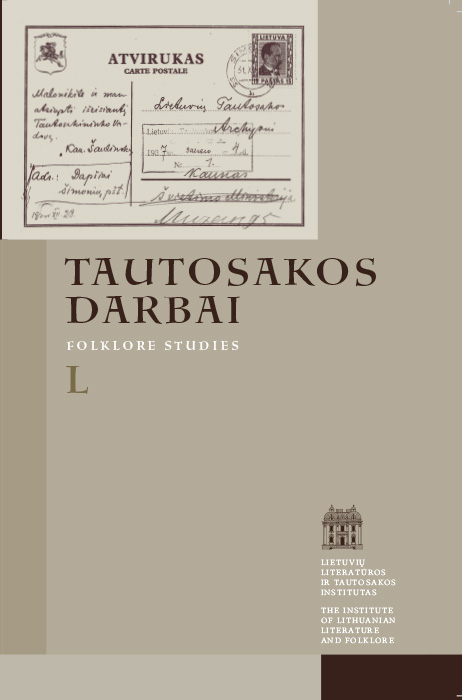Dainų sąsiuvinis kaip asmeninės raštijos formatas
Santrauka
Straipsnyje pristatoma viena iš rašytinio folkloro atmainų – dainų sąsiuviniai. Šis asmeninės raštijos tipas moksliniame diskurse kol kas nebuvo nuosekliau kauptas ir tyrinėtas. Tačiau jau antrą šimtmetį gyvuojanti dainų sąsiuvinių tradicija verčia pasvarstyti, kokios objektyvios aplinkybės galėjusios lemti tokią nuostatą jų atžvilgiu. Bandant atpažinti dainų sąsiuvinių tradicijos ištakas, jie gretinami su kitomis giminiškomis rašytinės kultūros formomis, taip pat, remiantis konkrečiais pavyzdžiais, gilinamasi į užrašų kontekstualumo aspektus. Formaliõsios rankraščių sandaros aptarimas padeda atskleisti dainų sąsiuvinių žanrinę specifiką ir pademonstruoti šios kultūrinės tradicijos gyvybingumą bei dinamiškumą. Atsiremiant į patirtis, atsiradusias tiriant lietuvišką medžiagą, taip pat pasiremiant užsienio mokslininkų įžvalgomis, bandoma nusakyti keletą tyrimo krypčių, kurios leistų tęsti šio rašytinio folkloro žanro interpretacijas.
Atsisiuntimai
Skaitomiausi šio autoriaus(ų) straipsniai
- Jurgita Ūsaitytė, Daina kaip propagandos įrankis: žvilgsnis į sovietmečio dainų sąsiuvinius , Tautosakos darbai: T 65 (2023): Tautosakos darbai
- Vita Džekčioriūtė, Aušra Žičkienė, Jūratė Šlekonytė, Gražina Kadžytė, Jurgita Ūsaitytė, Lina Būgienė, Daiva Vyčinienė, Kronika , Tautosakos darbai: T 48 (2014)
- Audronė Gedžiūtė, Jūratė Šlekonytė, Jurgita Ūsaitytė, Vita Ivanauskaitė-Šeibutienė, Kronika , Tautosakos darbai: T 57 (2019)
- Jurgita Ūsaitytė, Dainų recepcija tautinio atgimimo laikotarpio lietuviškoje spaudoje , Tautosakos darbai: T 58 (2019)
- Modesta Liugaitė-Černiauskienė, Jurgita Ūsaitytė, Pratarmė , Tautosakos darbai: T 69 (2025): Tautosakos darbai
- Jurgita Ūsaitytė, XIX a. antrosios pusės asmeniniai tekstų rinkiniai ir jų istorinis kontekstas , Tautosakos darbai: T 55 (2018)
- Jurgita Ūsaitytė, Iš albumistikos naujienų (dviejų studijų apžvalga) , Tautosakos darbai: T 52 (2016)
- Jurgita Ūsaitytė, Pratarmė , Tautosakos darbai: T 48 (2014)
- Jurgita Ūsaitytė, Pratarmė , Tautosakos darbai: T 63 (2022)
- Jurgita Ūsaitytė, Pratarmė , Tautosakos darbai: T 59 (2020)
